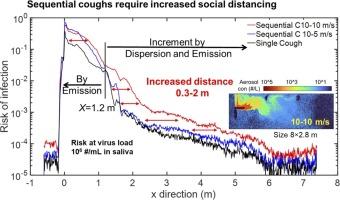连续咳嗽的气溶胶扩散增强和社会距离的影响
IF 11.3
1区 环境科学与生态学
Q1 ENGINEERING, ENVIRONMENTAL
引用次数: 0
摘要
连续咳嗽虽然很常见,但与单次咳嗽相比,在空气传播研究中受到的关注较少。在这项研究中,我们使用大涡模拟(LES)研究了连续咳嗽中的气溶胶扩散,并通过粒子图像测速(PIV)实验进行了验证。研究了两种类型的连续咳嗽,并将其与单次咳嗽进行了比较:一种咳嗽有两个相同的峰值速度为10米/秒(10-10米/秒),另一种咳嗽的峰值速度为10米/秒,然后是5米/秒(10-5米/秒)。在10-10米/秒的情况下,第二次咳嗽在2秒和1.2米时与第一次咳嗽合并,导致与单次咳嗽相比气溶胶分散增强。相比之下,在10-5 m/s的情况下,第二次咳嗽由于速度较低,在8 s和1.6 m处赶上了第一次咳嗽。10-10 m/s情景比10-5 m/s情景和单次咳嗽对气溶胶的分散能力更强。连续咳嗽使全范围内的感染风险增加2-4倍,并且由于气溶胶扩散和排放增强,需要平均增加0.5米的社交距离。这些发现提高了我们对气溶胶传播的理解,并为室内环境中的社会距离指南提供了信息。本文章由计算机程序翻译,如有差异,请以英文原文为准。

Enhanced Aerosol Dispersion of a Sequential Cough and Social Distancing Implications
Sequential coughs, although common, have received less attention in airborne transmission studies compared to single coughs. In this study, we explored aerosol dispersion from sequential coughs using large eddy simulation (LES), validated by particle image velocimetry (PIV) experiments. Two types of sequential coughs were investigated and compared to a single cough: one with two identical peak velocities of 10 m/s (10-10 m/s), and another with peak velocities of 10 m/s followed by 5 m/s (10-5 m/s). In the 10-10 m/s scenario, the second cough merged with the first at 2 s and 1.2 m, resulting in enhanced aerosol dispersion compared to a single cough. In contrast, in the 10-5 m/s scenario, the second cough, due to its lower velocity, caught up with the first at 8 s and 1.6 m. The 10-10 m/s scenario demonstrated a stronger capacity for dispersing aerosols than both the 10-5 m/s scenario and the single cough. Sequential coughs increased infection risk by 2-4 times across the full range and required an average increase of 0.5 m in social distancing, due to the enhanced aerosol dispersion and emission of aerosols. These findings improve our understanding of aerosol transmission and inform social distancing guidelines in indoor environments.
求助全文
通过发布文献求助,成功后即可免费获取论文全文。
去求助
来源期刊

Journal of Hazardous Materials
工程技术-工程:环境
CiteScore
25.40
自引率
5.90%
发文量
3059
审稿时长
58 days
期刊介绍:
The Journal of Hazardous Materials serves as a global platform for promoting cutting-edge research in the field of Environmental Science and Engineering. Our publication features a wide range of articles, including full-length research papers, review articles, and perspectives, with the aim of enhancing our understanding of the dangers and risks associated with various materials concerning public health and the environment. It is important to note that the term "environmental contaminants" refers specifically to substances that pose hazardous effects through contamination, while excluding those that do not have such impacts on the environment or human health. Moreover, we emphasize the distinction between wastes and hazardous materials in order to provide further clarity on the scope of the journal. We have a keen interest in exploring specific compounds and microbial agents that have adverse effects on the environment.
 求助内容:
求助内容: 应助结果提醒方式:
应助结果提醒方式:


